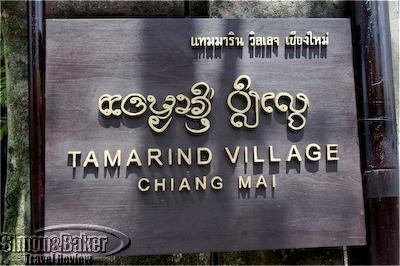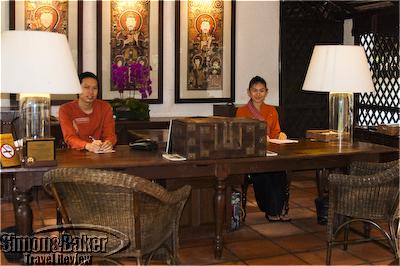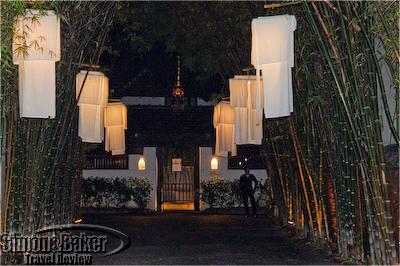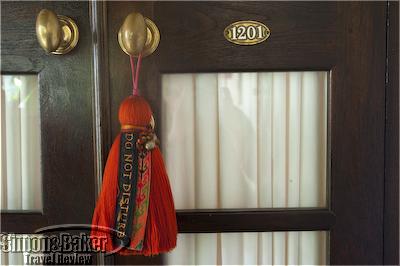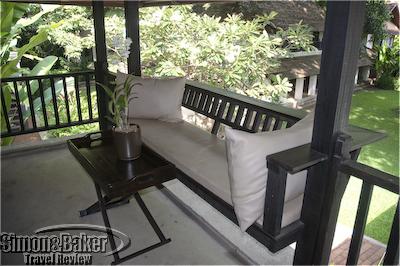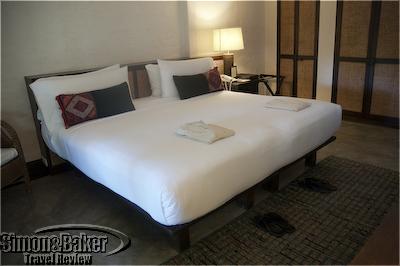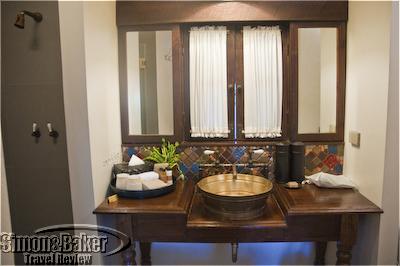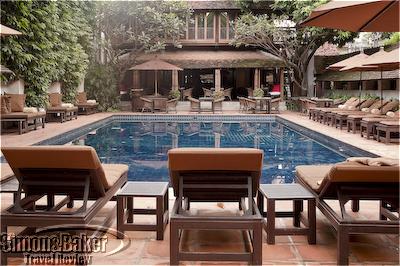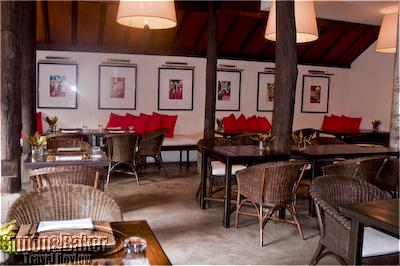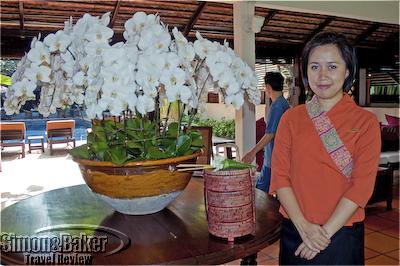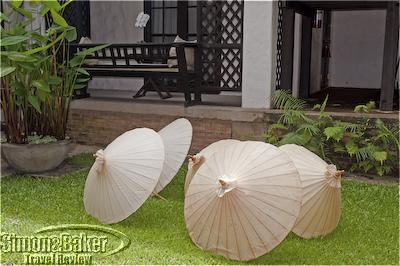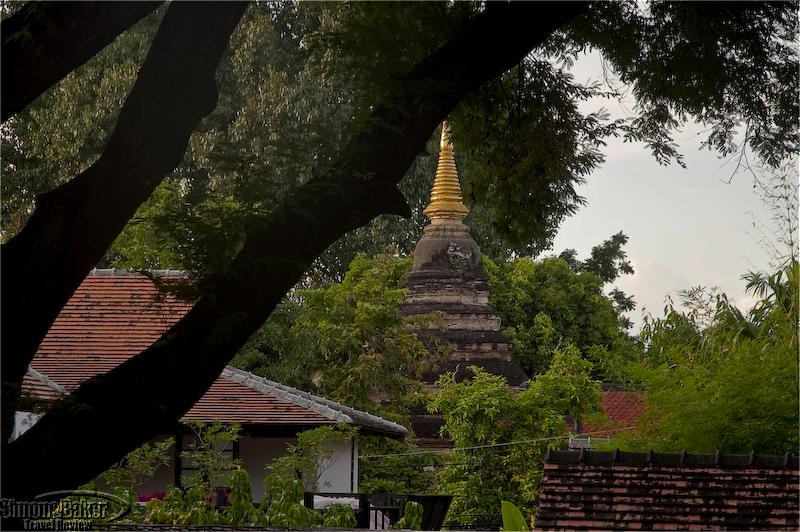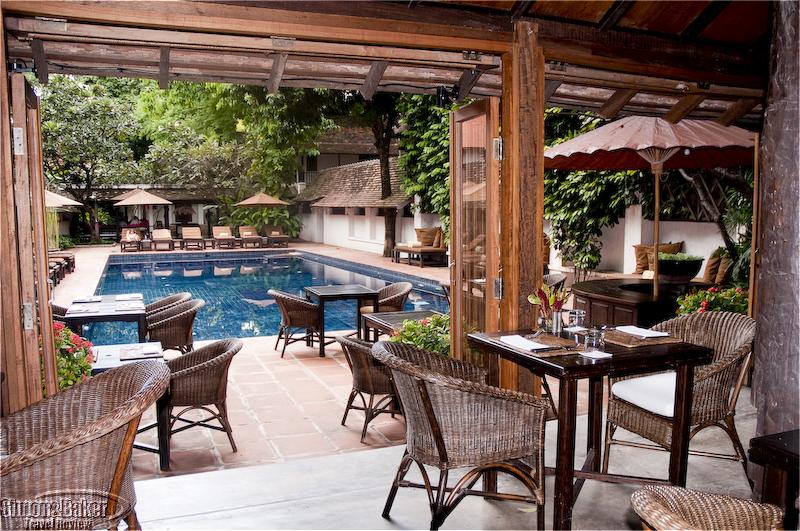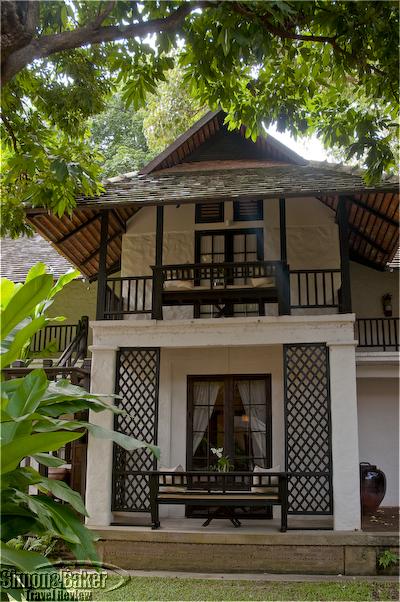
I was immediately seduced by the understated charm of Tamarind Village and the thoughtful welcome of its gracious staff that made me feel like a long expected friend. After ensuring that I was settled to my satisfaction, Kaksana Thanopajai, the property’s concierge and resident expert on Lanna Thai history and northern ethnic crafts, discussed my interest in this ancient culture. The Lanna Kingdom flourished in what is now Northern Thailand, from the 13 th to the 18 th centuries, with Chiang Mai as its capital. We decided on several activities, including a fascinating morning walk in the neighborhoods surrounding the hotel. With Kaksana as my guide, we stopped at Wat Duang Dee, a small temple located down the street from the property. There, we delivered the hotel’s traditional daily offering of food to the monks and received their blessings before proceeding to some of the most historic sites in the city (n.b. this complimentary tour was available daily to hotel guests by previous arrangement). Other memorable excursions included an afternoon drive high into the mountains surrounding Chiang Mai for a visit to a remote Hmong tribal village. On the way home we stopped at Wat Doi Suthep, a sprawling hilltop temple considered especially holy by many Thai people. The site also offered a panoramic view of the city below.
Tamarind Village itself offered a unique opportunity to appreciate many aspects of the rich cultural legacy of the Lanna Kingdom. The public areas and guest rooms were decorated with antique crafts and colorful textiles drawn from the various tribes of the region. At the restaurant, in addition to Thai and western fare, one-third of the menu was dedicated to typically northern cuisine. Above the restaurant, a small art gallery regularly hosts temporary expositions inspired by northern topics. At the time of my visit, the exhibit was entitled “Dreams of the North; nuance and nostalgia in contemporary jewelry.” Then there was the charm of the surroundings, especially at dusk when the entire property became imbued with a special kind of magic. I loved to settle into the deep cushions of the settee on my balcony then, and gaze through the branches of the ancient tamarind tree at the last rays of sunshine brushing the golden spear of Wat Duang Dee. Meanwhile, oil lanterns were being lit along the garden paths and around the pool where their reflection danced in the undulating water. Soft sounds of temple bells and chants drifted over the Village wall and with them the spirit of a culture dating back a millennium.
With its privileged location in the heart of the historic town, its refined ethnic atmosphere and warm and attentive staff, Tamarind Village appeared to be a favorite of a broad range of tourists from honeymooners and groups of friends to vacationing families. And it also attracted some business travelers. I thoroughly enjoyed my stay there and would gladly plan a longer visit, using Tamarind Village as a base to explore the tribal areas of Northern Thailand.
Class Of Accommodation Luxury boutique hotel
Concierge Kaksana Thanopajai
Connectivity There was complimentary WiFi connectivity throughout the property. Access from my suite was reliable and fast.
General Manager Naphat Nutsati
Handicapped Access No
Length Of Stay Three nights
Location Within the walls of Chiang Mai’s historic city, a 20-minute drive from the airport.
Owned- Managed Tamarind Village was owned and managed by the Premier Group of Companies.
Pets Allowed No
Size The one-acre (4,046 square meter) property included 42 rooms and three suites in two level structures set around three private courtyards. It could accommodate up to 90 guests and employed a staff of 60.
Year Opened-Renovated Tamarind Village opened in 2001. The bathrooms were fully renovated in 2006. The spa was added in 2007.
Room The décor of my 325 square foot (30 square meter) Lanna Deluxe Room, Number 1201, continued the rustic theme of the common areas, with whitewashed rough-plastered walls and cathedral ceilings, anthracite gray polished concrete floors and dark wooden furniture with natural woven rattan inserts. It harmoniously combined the elegant simplicity of organic materials with modern comforts. A pair of French doors, curtained in shirred white cotton led into the room. A tan and dark green woven cotton throw rug outlined the foot of the king-size platform bed clad in crisp white high-count cotton. On the right of the bed, a bedside table held a tall lamp with a rattan cylinder base and a natural parchment shade. A barrel-shaped armchair with a white canvas cushion sat on the left of the bed. On the opposite wall, a writing desk with a wooden stool and desk lamp, and an armoire that held the television set stood on either side of the entrance door. A colorful display of rustic lacquered boxes and intricately embroidered tribal children’s hats in multiple shades of red stood on top of the armoire. A framed contemporary etching of classic northern Thai graphics hung above the desk. A tray with a tea and coffee service, and two lacquered cylinder boxes holding bottles of water were tucked in the corner next to the desk. Two large floor-to-ceiling closets on either side of central double doors partitioned the bedroom from the bathroom. At the front of the room, French doors opened onto an inviting roofed balcony. A loveseat was built into the railing. In front of it a low butler’s tray held a pot of white orchids. I especially enjoyed lingering there to reminisce on the day’s activities, or process my e-mail (via the room’s WiFi connection); or simply watch birds flutter about the flowering trees that bordered the courtyard.
In addition to a variety of tempting Thai and international dishes, the menu offered a selection of authentic northern Thai dishes, from original family recipes said to have been handed down through generations. While I cannot speak to the veracity of this claim, I can vouch for the success of the outcome. I ordered all my meals from the northern Thai menu, including breakfast when I eschewed the standard buffet offerings for a more traditional Thai soup. My dinner favorites were deep-fried bamboo shoot stuffed with ground pork, served with a hot but sweet peanut sauce; fish marinated in curry, then served en papillote in banana leaves over jasmine rice, and a divine coffee custard which I ordered repeatedly.
Facilities Ruen Tamarind, the restaurant, the Village Spa, a swimming pool and a gift and clothing boutique.
Gift Shop The attractive gift boutique was located next to the reception area. It offered a selection of clothing made from tribal textiles, antique crafts and art pieces, souvenirs created by local designers and some interesting custom and ethnic jewelry. At the time of my visit, it also featured a limited selection of gold and silver jewelry by the artists on display in the hotel’s art gallery.
Pool The 25 by 58 foot (7.65 by 17.60 meter) swimming pool was set in a sunny terracotta-tiled terrace filled with tropical plants and flowers. On two sides, the pool was surrounded by lounge chairs with apricot-colored cushions under matching garden umbrellas. On the third side, there were three daybeds lined along the high outer wall of the property, an ideal spot for sunbathing. The fourth side was the restaurant terrace, furnished with square dining tables and rattan armchairs for al fresco poolside meals.
Spa The Village Spa was a serene sanctuary located on the second floor of the most secluded courtyard within Tamarind Village. The public areas of the spa embraced the Lanna Thai architectural concept of open galleries under a tiled roof. Besides the large polished wood reception desk, the area was furnished with antique chests holding pottery bowls overflowing with impressive arrangements of orchids. Loveseats were built into the galleries’ railing to face the doors of the six treatment rooms; their white seat cushions effectively showed off a profusion of pillows covered with intricate tribal weavings in shades of crimson and fuchsia.
Veenarat Sumrej, spa supervisor, offered me a refreshing herbal beverage and invited me to select from an assortment of natural essential oils the scent I would prefer for my massage. She explained that the spa used only herbal products drawn from the Lanna Thai heritage of natural healing. She recommended the Village Signature Massage to restore my travel-weary body, and introduced me to my therapist, Phailin Duangkum. After a traditional foot bath and short foot massage, Phailin ushered me into my private treatment room. The 90-minute Signature Massage was a heavenly combination of deep-tissue massage and application of heated herbal pouches. It soothed every fiber of my body, left my skin velvet smooth and my psyche so contented that I couldn’t wait to return. I did the next day after a long hike in the mountains, for a foot reflexology treatment, which left not only my feet but also my entire body in such a state of wellbeing that I wished I could package the experience and bring it home with me.
Date Of Review October 2010
Reviewers Article and photos by Josette King
Service The room was serviced twice daily. Staff members were unfailingly attentive and friendly.
Would You Stay There Again? Yes
Contact Information
- 50/1 Rajdamnoen Road
- Sriphoom, Muang, Chiang Mai
- 50200 Thailand
- + 66 53 418896-9
- + 66 53 418900
